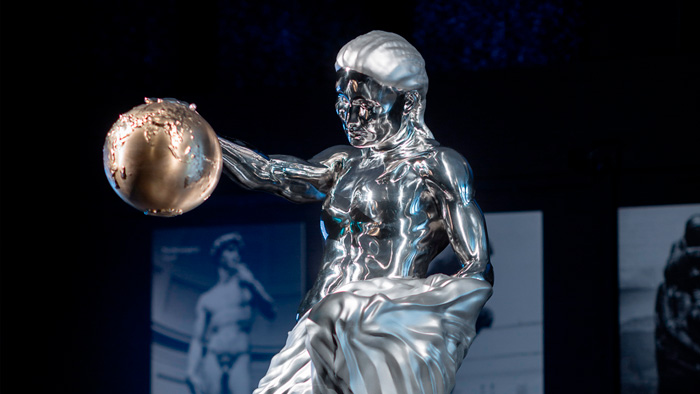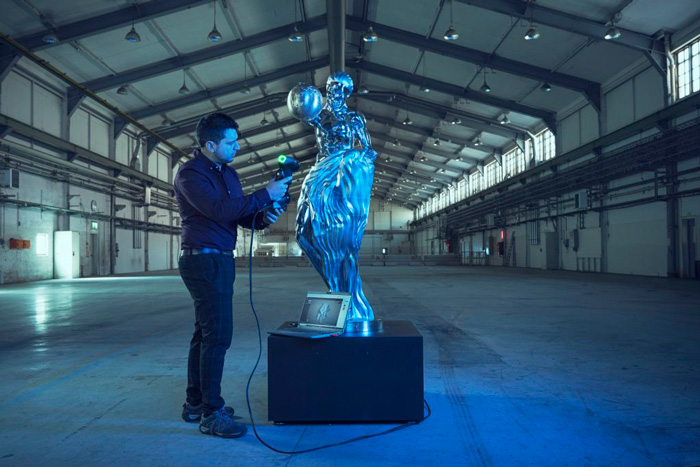
Discover the world's first AI-generated statue
A statue generated by AI (artificial intelligence). Titled “The Impossible Statue,” the work came to life through a collaboration between The AI Framework, a consultancy, and Sandvik, an engineering company specializing in metal cutting, which pushed the project as a means of displaying its manufacturing programmed by computer.
Although this project is art-centric, the manufacturing methods involved in creating the Impossible Statue differed little from other tasks, said Nadine Crauwels, president of Sandvik Machining Solutions: “Using all of our resources, we can significantly improve manufacturing efficiency, reduce waste, and ensure the highest quality.”
The creation process
First, they trained AI models on the work of five sculptors, weaving Michelangelo's contrapposto, Rodin's musculature, Käthe Kollwitz's naturalism, Takamura Kotaro's movement (Rodin's great follower) and the boldness of Augusta Savage's figures. The Sandvik team essentially cherry-picked the most desirable attributes of some of the most famous sculptors of the last five centuries and then repeatedly generated images using a combination of Stable Diffusion, DALL-E and Midjourney until they were satisfied.
AI generated statue

The Impossible Statue. Photo courtesy of the Swedish National Museum of Science and Technology.
The result is an androgynous figure composed of shifting tones of steel that holds a globe, which goes against the laws of gravity, and whose lower half is entangled in a corrugated sheet of metal. Are the invisible hands of the aforementioned sculptors evident? Somehow. The musculature is certainly bold and the fabric feels like a contemporary reworking of a Renaissance fixation. But again, the darker social commentary presented by Kollwitz and Savage's work seems absent in a statue full of promise.
After defining a design, Sandvik converted the 2D image into a 3D model using depth estimation and human pose estimation software, a computer task that identifies different parts of the human body in a scene. The company then thoroughly tested the manufacturing process in a series of digital simulations, halving the amount of steel used in the process. The statue produced was composed of nine million polygons, 17 separate pieces of steel, and differed from the digital drawing by less than 0.03 mm.
AI generated statue

Sandvik worker checking the accuracy of the statue. Photo courtesy of Sandvik.
“The Impossible Statue is a great example of what the combination of modern technology and human brilliance can create,” said Peter Skogh, director of the Museum of Science and Technology, in a statement. “Our mission is to create a broader understanding of the possibilities of technology and nurture the next generation. This project is ticking all the boxes for us.”


- April 14, 2025
Gallery of Illustration by Luis San Vicente – Mexico

- April 14, 2025
Art, Culture, and Technologies for Peace

- April 14, 2025
Cuartel del Arte Exhibits “Graphic Paths”


- April 14, 2025
Gallery Of Illustration By daria filippova - Ukraine

- April 14, 2025
Gallery Of Humor Drawing By Fahd Bahady - Syria



- April 14, 2025
Analysis of Artistic Works Created with…

- April 13, 2025
From Digital Art to Contemporary Art

- April 13, 2025
The Expansion of Photography

- April 12, 2025
When is photography considered art?

- April 10, 2025
Impact of AI on the Diversity of Artist…

- April 10, 2025
How can AI enhance artistic creativity?

- April 09, 2025
The Impact of Artificial Intelligence o…

- April 08, 2025
Latin American art, a goldmine of oppor…

- April 07, 2025
Contemporary Art in Brazil: Between the…

- April 07, 2025
Mexican Muralism: Art for the People

- April 06, 2025
History of graphic art in Brazil

- April 05, 2025
Modern Art: A Renaissance in Art History

- April 02, 2025
Aldo Estrada (Ilustronauta): From Peruv…

- March 31, 2025
How ChatGPT is Turning Photos into Japa…

- March 30, 2025
Arístides Hernández (ARES): A Sharp Min…

- March 30, 2025
The Masters of Cuban Caricature: Celebr…

- March 29, 2025
Where Will Artificial Intelligence Take…

- March 27, 2025
A Few Fascinating Features of Latin Ame…

- March 27, 2025
9 Key Books to Understand Latin America…

- March 26, 2025
The Underground: A Glimpse into 1930s L…

- August 29, 2023
The history of Bolivian art

- February 19, 2024
Analysis and meaning of Van Gogh's Star…

- January 28, 2024
Culture and Art in Argentina

- September 25, 2023
What is the importance of art in human …

- September 23, 2023
What is paint?

- August 10, 2023
14 questions and answers about the art …

- August 30, 2023
First artistic manifestations

- August 23, 2023
The 11 types of art and their meanings

- March 26, 2024
The importance of technology in art1

- August 16, 2023
The 15 greatest painters in art history

- September 23, 2023
History of painting

- April 06, 2024
History of visual arts in Ecuador

- March 26, 2024
Cultural identity and its impact on art…

- January 31, 2024
Examples of Street Art – Urban Art

- January 20, 2024
What is the relationship between art an…

- August 25, 2024
A Comprehensive Analysis of the Cartoon…

- April 07, 2024
Graffiti in Latin American culture

- September 23, 2023
Painting characteristics

- October 21, 2023
Contemporary art after the Second World…

- March 05, 2024
The art of sculpture in Latin America

- February 19, 2024
Analysis and meaning of Van Gogh's Star…

- August 13, 2023
9 Latino painters and their great contr…

- August 29, 2023
The history of Bolivian art

- August 10, 2023
14 questions and answers about the art …

- January 28, 2024
Culture and Art in Argentina

- August 23, 2023
The 11 types of art and their meanings

- November 06, 2023
5 Latin American artists and their works

- September 23, 2023
Painting characteristics

- August 27, 2023
15 main works of Van Gogh

- September 23, 2023
What is paint?

- September 25, 2023
What is the importance of art in human …

- August 30, 2023
First artistic manifestations

- January 20, 2024
What is the relationship between art an…

- January 12, 2024
10 most beautiful statues and sculpture…

- December 18, 2023
10 iconic works by Oscar Niemeyer, geni…

- October 30, 2023
Characteristics of Contemporary Art

- March 26, 2024
Cultural identity and its impact on art…

- August 22, 2023
What are Plastic Arts?

- April 16, 2024
The most important painters of Latin Am…

- October 11, 2023


